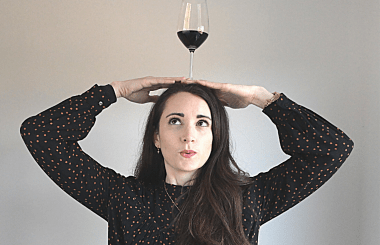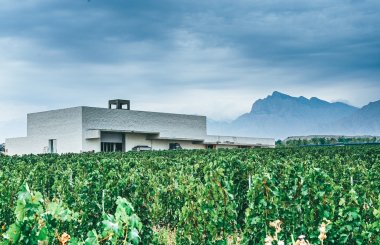IWSC Business Insight: How to get your wine listed on airlines
What’s been the biggest effect of Covid on airline wine buying?
Airlines have had to stockpile more wine than they have been able to use, so a whole year’s tender has been lost. Not only that, but producers and brokers who bank on airlines buying significant parcel sizes have been left without their best customers this year. Having said that, airlines are responsible buyers and most of the partners I work with are honouring their purchasing commitments and will take the wine they’ve promised to.
Another significant factor is format size. A surprising number of carriers switched from a 75cl bottle to quarter-size single-serve bottles in the midst of the pandemic. I suspect this was a knee-jerk reaction to avoid cross-contamination, but it’s just not realistic to expect Business and First customers to pay the same ticket price then be served a wine from a 187ml PET bottle. Fine-wine producers do not use small bottles and I would hazard a guess that they aren’t about to start doing so.
How do airlines calculate the quantity of wine required?
A: It’s based on the previous year’s passenger numbers plus a percentage increase for any forecasted growth, but the actual volumes required are immense. For example, I listed 7,000 bottles for each of the six sub-categories of still wine in First Class – that’s 42,000 per month, excluding sparkling and fortified, plus the other drinks on the list. That figure rises from 42,000 to 132,000 for Business, again not counting sparkling or fortified wines.
It’s why airlines can only carry a small and restricted choice in-flight. Galleys and bar carts can only fit so much, and once you add weight restrictions and fuel costs (more than £4 million is attributed to just one teabag flying around in a year), it’s clear that the more choice offered, the less of each will be available, so you’re just creating disappointment.
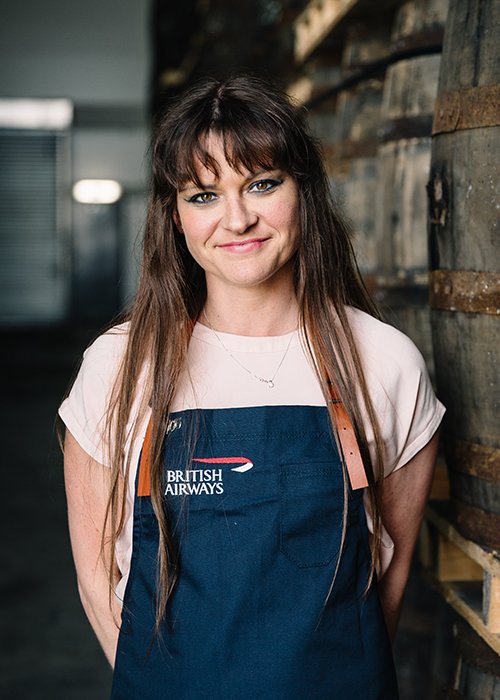 Kelly Stevenson is the founder of JetVine, a consultancy focused on drinks and aviation
Kelly Stevenson is the founder of JetVine, a consultancy focused on drinks and aviationDescribe a typical wine list in First Class…
There’s a standard formula:
- Red Bordeaux – the quality here should be grand cru classé. It’s here and in the next category where differences can be seen from one airline to another
- White Burgundy – over the years, some lists have lost their Chassagne and Puligny Montrachets, but very pleasant examples from Chablis and other village crus are common
- Light Reds – generally Pinot Noir or very good Beaujolais. There’s been a growing trend for New World Pinot, especially from Central Otago
- Robust Reds – here, one would expect to see Rioja of at least Reserva quality, or a fine New World Malbec or Shiraz
- Sauvignon Blanc – not only is it a superb wine at altitude, with an intense bouquet and myriad complex notes, but it’s also a firm favourite inside the cabin
- Aromatic Whites – the catch-all term for pleasant white wines. You may see a fine Albariño from Rías Baixas or a good Australian Viognier
The remaining First line-up normally consists of:
- Champagne – Vintage or Grand Cuvée
- Champagne: Rosé
- Other Sparkling: at BA, we always listed English fizz
- Sweet/Dessert Wine: Tokaji was always a customer favourite
- Port – Colheita, not Vintage, as decanting in-flight is not an option!
Which styles are the most popular?
In the four years I managed the wine portfolio for BA, one thing remained constant: in lounges, customers drank 50% more white wine than red – but in the air, they drank 50% more red than white. I guess customers in the lounge see it as an opportunity to enjoy a white wine as an aperitif, then change to a more powerful red on board as they tuck into their main course.
Otherwise, the styles of wine airlines look for are ready to drink. A young Bordeaux bursting with tannin that will be great in 10 years’ time is no good to airlines who tend to buy wines to age around three years before they serve them. Equally, be careful with acidity. Searing acidity will taste off-balance at altitude. Fruit-forward, smooth, well-rounded and ready-to-drink wines are ideal.
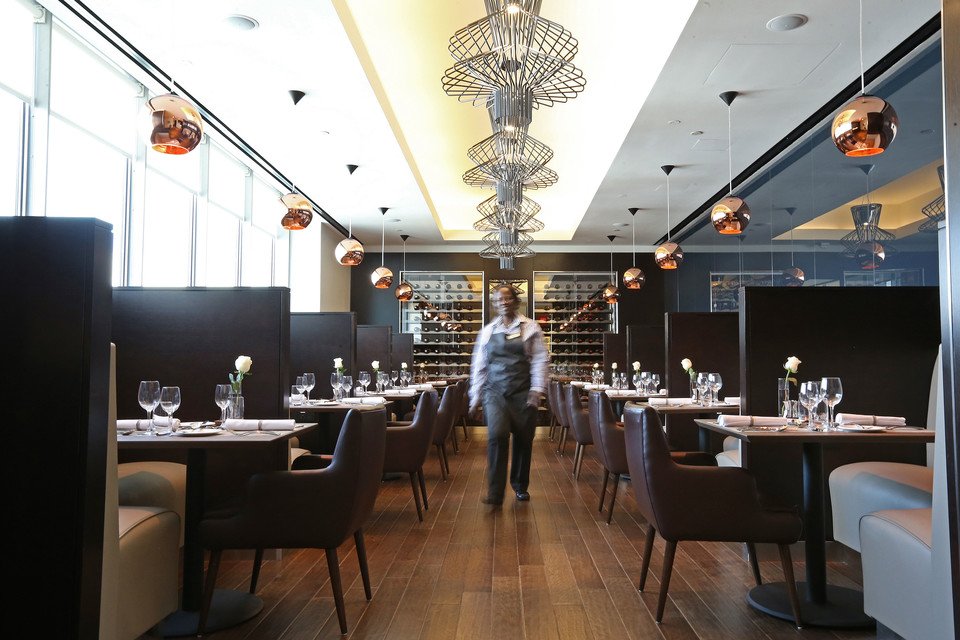
British Airways' Washington Lounge
And how big is Champagne and sparkling wine?
Huge! Despite globalisation, ease of travel and shorter flying times, it’s still special to clink a flute filled with fizz against your fellow passenger’s glass. It’s synonymous with flying the world over and is second only to a good G&T in terms of popularity.
But I do feel there’s a barrier to entry for sparkling wine producers. In some cases there’s a reluctance to change, or a belief that it must be Champagne or nothing. In actual fact, there are many gaps and a huge captive audience for other sparkling wines of the world – many will hit the right price point, too. I predict we will start to see more of the wonderful Cavas, Crémants and Proseccos the world has to offer.
A lot of people believe that wine tastes different at 30,000ft – is this true?
Physical taste buds do not change. There’s a dumbing down of the senses and an increased perception of dehydration in-flight, so for this reason, the wines (and foods) listed should accentuate every characteristic to the extreme. At 36,000 feet, intensity can be affected, so a spicy Shiraz should have an identifiable peppery spice and be fruit forward with lots of brightness and body.
If the wine isn’t hugely complex during tasting, or the vintage is weaker than the previous year, the profile of the wine will get utterly lost at altitude. Similarly, an oaked Chardonnay needs to be full-on, new oak, lees stirred, the works – otherwise the oak or fruit won’t be well balanced.
Does the flight route affect the choice of wine on board? Would Heathrow-JFK get a different selection to Heathrow-Beijing, for example?
When I started [at BA], we selected the wines on a global/regional basis. The world was split into five regions, with a different menu for each. Then in 2017 we introduced ‘tiering’, which consisted of four tiers/groups. Each one had a pre-determined route list, then the wines were chosen and allocated to a tier.
Where volume could not be found for an entire month’s run, two wines were selected and allocated to either East or West. In some months, the network carried the same wines, and other months, South Africa had a different list to Australian routes, and so on. The overall objective was to assign the best-quality wines to the highest-performing routes, but generally speaking, the likes of New York, Singapore, San Francisco and Tokyo got the best wines, with other routes having a more budget-friendly list.
What are the key differences between the wine offering in airport lounges and First/Business/Economy Class?
Well, obviously, First is top of the tree. In Business, where there isn’t as much choice as First, they should still be great-quality wines. Typicity is important, too, as the choice drops to two red and two white wines. When there isn’t huge choice, it’s important that what is chosen is how it should be. Rioja, for example, should be traditional, aged in American oak and full-bodied, with vibrancy of fruit. Viognier should be floral, fruity and young so that the youthful crispness can still be detected even at high altitude.
The lounge experience is a big deal and one of the ways airlines can differentiate from the competition. It’s important to remember that it’s ground-based, too! It isn’t a pressurised cabin, small and svelte with minimal space; it doesn’t have weight restrictions or a highly pressurised atmosphere with a potential to tarnish your taste buds.
With lounges, you have choice, POS material, tastings and events. The lounge is a hidden gem for producers, giving them the chance to trial product and sample to audiences with the highest dwell time of any media channel in existence. And for airlines it’s the opportunity to try before you buy, and assess popularity before committing to the complex logistics of loading a new product in-flight.
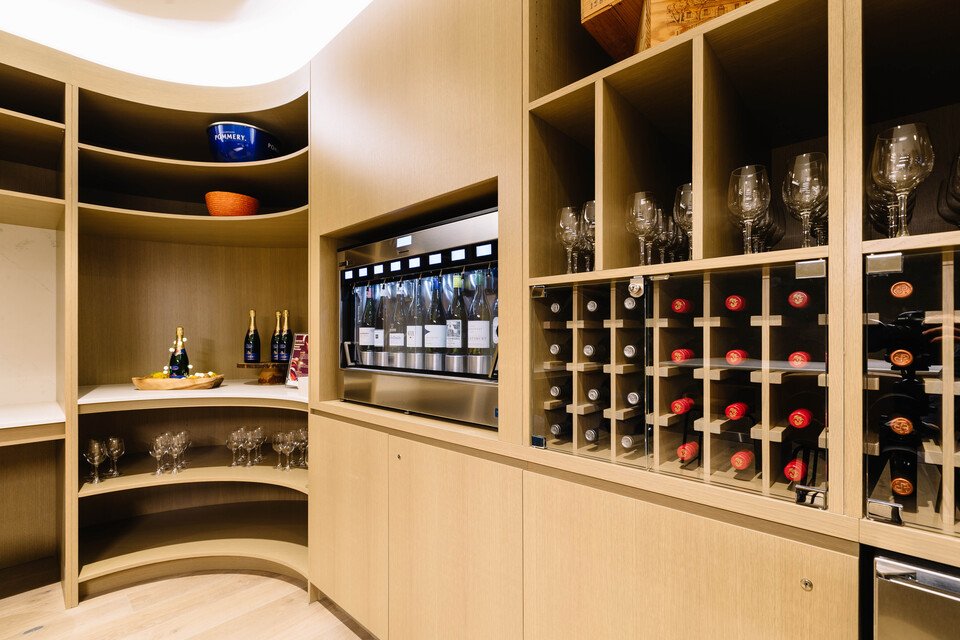
British Airways' JFK First Lounge
How does flight time affect the wine offering?
Shorter flights mean less time for service, and often the aircraft are smaller, too. Producers of 187ml PET wine are targeting these smaller aircraft (and ships and trains, too). Great quality is difficult to find because there aren’t the same wines available in 187ml compared with 75cl for long-haul Business and First, so usually a different range needs to be identified.
Why 187ml bottles? It takes cabin crew 24 seconds to serve from a full bottle into a glass compared with around six seconds to unscrew a small bottle, place it on the tray-table with a glass and allow the customer to pour. A flight from London to Manchester consists of 23 minutes’ flying time, with three minutes each side for take-off and landing. With 42 customers and two servers, every second counts. If an airline does pour from 75cl bottles in its short-haul business cabin, they will almost always insist on screwcap wines for this reason.
How much do airlines buy direct from producers?
This is an ever-changing landscape. Some airline buyers believe that procuring such high volumes of wine every month should always be direct, while others are tied up in historical deals with dedicated wine merchants.
At BA, I found that some regions operate much better via brokers or agents who are highly skilled and can get access to the finest wines at the best prices. In contrast, some regions have winemakers who are happy to sell almost their entire vintage to one airline and would be crazy not to deal direct, cut out the chain and carry out a simple negotiation.
Like the wine industry, there is no one way of doing things and a good airline wine buyer will have a number of differently penned contracts filed away. Essentially wine should be treated with respect and if a winery wishes to sell direct or via a broker, then the buyer should acknowledge this and respect that as the route to purchase.
How do you see the future of airline wine?
In a can! What a fabulous innovation for an environment that needs consistency of serve, environmentally friendly material, an easily stackable format in small spaces and weighs as little as possible. But the most important of all – taste. Producers can now make wine that actually tastes like wine, like great wine, in fact, and from a can. To those producers who have added a little aluminium player to their team: bravo!
Not only that, but in the past, drinks producers were selling to airlines who in turn would give away the product to customers. Airlines give away food and drink – it’s part of your ticket, it’s what they’ve always done. No more. Lufthansa and Austrian Airlines have already announced that their food and drinks onboard will be retail not complimentary. This opportunity is genius because for producers, there’s suddenly a profit margin up for grabs. For the first time, independent, eco-friendly, great story-telling brands can grab a piece of the airline pie.
The industry has seen many crises in recent times but even WWII, 9/11, the volcanic ash cloud and the 2008 economic downturn never caused such a significant downturn in passenger traffic and the mass grounding of so many aircraft as the Covid pandemic. The disruption for aviation is unprecedented. However, like hospitality also hit hard, airlines are made of strong stuff and passionate, hardworking people with a unique ability to survive even in the eye of the storm.
I think that the here and now of the airline industry is a brilliant place to be. We’re seeing the start of what is going to be a seismic revolution for in-flight service, My advice to producers is to get on this wave and ride it for as long as possible.
Kelly Stevenson’s top tips for breaking into the airline market
1. Understand the environmentAirlines are dealing with size constraints, packed, confined trolleys and small compact galleys. There’s a weight consideration for both avionics and fuel cost. What service are the cabin crew delivering – a 75cl pour or handing out quarter bottles? Who buys, how do they buy, when do they buy and what do they buy?
2. Route supply chain
Ensure you ask the question ‘Where does the wine need to be delivered to?’ early on in proceedings. Is it one hub or is delivery required to multiple catering stations globally? Is the facility big enough to take a whole shipment or is there a maximum order quantity that cannot be exceeded?
3. Added value
Do you have something your competitors don’t? Do you have the capacity to offer a bespoke cuvée or a unique label? Do you have a significant marketing budget and can offer a portion for mutual benefit? Can you provide education and training to the airline teams who will present your product to the customer? Have your wines won any prestigious awards?
4. Don’t expect to get rich quickly
Aviation as a channel is not a great profit generator but it does provide a platform for extensive brand awareness, and is a great way of selling a huge chunk of volume all at once. Cellar-door pricing means non-transparent cost negotiations but the margins are tight. Go in low or you won’t see stage two of a tender.
5. Consider the lounge
Airport lounges are a great, less-complex environment to trial products and physically share your brand with customers who often have time to waste and are thirsty for new experiences.

